Vasari, the Palazzo Vecchio and the History of Florence (Begins Introductions to Historic Cities Series)
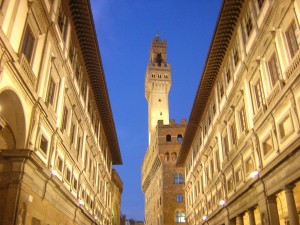
On July 30th Florence, the Uffizi gallery, Google and numerous other Earthly powers celebrated the 500th birthday of Georgio Vasari (1511-1574).
Both praising and describing Vasari are challenging, since no one could in fairness call him one of the Renaissance’s best painters, nor one of its best architects, nor even one of its best biographers. His Lives of the Artists is certainly what has brought him the most fame, but this collection of brief biographies of Renaissance artists is not only dry but unreliable, both in the poor-fact-checking-sense and in the extreme and unblushing bias which is as ubiquitous in pre-modern biography as tomato sauce on an American pizza. We read Vasari today only because he was these artists’ only biographer, and needs must as the paucity of sources drives. Yet, if Vasari was surpassed by many in arts and letters, walking the streets of Florence today I can think of few who touch him in footprint. He was a Great Figure of the Renaissance, one whose touch I feel constantly as I cross squares and explain architecture to new-made friends, to whom I find myself constantly repeating, “Of course, that bit wasn’t like that back then—it was redone by Vasari.” In brief, Vasari redid the Palazzo Vecchio. At length, in order to avoid making Vasari seem to be a petty, place-seeking stooge, I’m afraid I have to go back a ways…
Once upon a time the Roman Empire ended, and with it the network of roads and trade and safety that had strung cities together into a web of economy and culture. Small, unsteady kingdoms followed, but in Northern Italy at least, while cities formally passed from prince to distant prince, the absence of real central infrastructure and enforcement left them virtually alone. Italy’s cities became citystates, ruled by remote powers, pope or Emperor, in name only, while in reality they governed themselves, walled islands of population and production, independent and, at first at least, many republican. They had Rome as their model, an elite voting population and elected offices, not quite the same as the old republic but close enough to breed patriots as proud as Cicero. But these little city republics, like Rome’s, weren’t stable. Faction fighting bred civil war, brought on partly by ambitious families but more often by that Hobbesian principle that anyone powerful or rich enough to be envied by his neighbors can never sleep safe at night until he has deprived said neighbors (through subjugation or execution) of the ability to kill him in his sleep. Winners became rulers and one-by-one the city republics became the seats of lords and dukes and counts and other-titled princes. (This is all oversimplified, of course, but the romantic narrative is more important than the gritty details when our purpose is to understand what the Palazzo Vecchio means as a symbol of what was.)
Florence held out longest of the great cities (excepting Venice; we must in all things except Venice, since Venice is that special), Florence the stubborn, free, fractious, strange Republic. Over and over it nearly fell, as ambitious nobles and entrenched vendettas (think Montagues and Capulets) made the streets stream with blood and the road with exiles, Dante among them. From a pure body-count perspective there is no way around admitting that the surrounding cities that did turn to monarchies were better off, stable, efficient, comparatively immune to faction fighting, but free Florentines would never sacrifice liberty and dignity for ease and calm—and this includes the vast, disenfranchised majority who were not members of the voting elite but still took pride in their Republic.
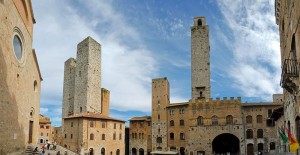
After one near-tyrant too many, the Florentines decided to create a system of government which could never, ever let anyone gain enough power to take over, and so conceived the Signoria, a system so bizarre that if someone made it up in fiction no reader would think it plausible. The Florentines had long since exiled, killed or at least banned from government all their nobility. The private towers of the powerful families, which had once turned Florence into a forest of tiny battle-ready fortresses, were knocked down, their palaces burned, and a new law forbid any private citizen from building tall towers which could be used as private forts to defend elite families as their goons battled in the streets below. What remained as the elite were members of the merchant guilds, the great trade families who controlled cloth production, oil, wine, medicine, bureaucracy and, that great Italian invention, banking. A Signoria, or council of elected rulers, was created in 1282, a vaguely-defined political body also used by several other Italian republics. Florence’s unique system of “scrutiny and lot” was introduced in 1328, in which each qualifying member of the great guilds over thirty years of age was examined for fitness and then his name was put in a bag. Every two months nine names were pulled out, and these nine men became the Signoria, the ruling council, to rule the city for two months. At the end of these two months new names were drawn, so no one ever ruled alone, and no one was in office anywhere near long enough to form a personal power base. There were no elections to fix or sway with bribery and campaigning, so all would remain fair and stable and happy ever after. In theory, at least.
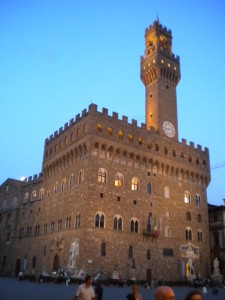
The Palazzo Vecchio (begun in 1299, the year before Dante went to Hell), was built to house the Signoria, and while in office they were held within the palace and never permitted to leave, since outside they could be bribed, kidnapped, even contaminated by passing heretics or devils (horror!). The palace was built on the crater left when the victorious Guelphs razed to the ground the palaces of their Ghibelline rivals (think Montagues on the smoldering graves of Capulets) and instantly became the symbol of the unity, stability and prayed-for longevity of the noble Republic.
The apartments of the Signoria, grandly decorated with painted wooden ceilings, were on the top floor. The ground floor was originally open, a place where people could gather and talk and trade. It was later closed in so a garrison could defend the palace from attack. On the lower levels, representatives of the people receive the laws sent down by the Signoria, and could vote to accept or reject them. An intermediate floor between the council level held the scribes and clerks and secretaries who kept the system running.
Yes, Assassin’s Creed fans, there really was a prison in the tower, and if someone you know was imprisoned there, that means he was very, very naughty.
Finally the great tower was a symbol of the supremacy of the republic, and at the top a special prison was built to hold the most dangerous traitors against the state, who were sometimes executed by being hanged off the tower itself.
A completely unfounded but nonetheless delightful urban legend holds that the semicircular battlements on top of the tower, associated with the defeated Ghibelline faction in contrast with square battlements used by Guelphs, represented the vicious, Ghibelline-leaning traitors imprisoned there.
Problem is, the Signoria system had one vital flaw:
(A new Signoria is elected)
Duke of Milan – Hello, Signoria. I’m the Duke of Milan. Congratulations on your election. Have a fruitcake.
(1 week passes as the Duke’s message is carried from Milan to Florence)
Signoria – Nice to meet you, Duke of Milan. Thanks for the fruitcake. We knit you this nice scarf.
(1 week passes as the Signoria’s reply is carried back)
Duke of Milan – Thanks for the scarf. Now that we’re friends, would you like to make a treaty for mutual defense against the French?
(1 week passes)
Signoria – Sure, we hate the French. What do you propose?
(1 week passes)
Duke of Milan – I propose committing X many troops, Y many florins, and everyone involved gets cookies every Thursday in honor of St. Ambrose.
(1 week passes)
Signoria – We want to send W many troops and Z many florins, and we demand that the cookies be distributed in the name of St. Zenobius.
(1 week passes)
Duke of Milan – Perhaps X many troops but Z many florins, and the cookies can be distributed in the name of both saints?
(1 week passes)
Signoria – Who are you? What are you talking about? We don’t want to give our troops and florins to someone we’ve never talked to! And we abhor cookies!
(1 week passes)
Duke of Milan – You had another election, didn’t you? Hi, Signoria, I’m the Duke of Milan. Have some fruitcake. Now, about the French…
No Tyrants within these Gates (David agrees).
Needless to say, the Signoria system was not popular with foreign powers who needed to negotiate with Florence’s government, nor with Florentines who needed to negotiate with Florence’s government, since the toothlessness which made the Signoria tyrant-proof also made it about as streamlined as a hedgehog. It certainly didn’t help that the guild members generally had no experience of government, and two months is far from long enough even to learn the ropes. Hence the rise of the Medici.
You see, there’s this brilliant thing called ‘banking’ which means you can leave your money with people in one city, and then go to another city and receive the same amount of money (minus a small fee), without having to carry bags of gold with you on the road where, in the absence of a real empire, bandits and adventuring parties roam free. The savings, in cash and in not getting your throat slit, made this option instantly popular, and the Italian families who did it instantly wealthy. The Medici managed to finagle the position of Official Bankers to the Pope, which meant that it was their job to escort donations, church taxes, land rents, indulgence fees and every kind of income from every church in Christendom back to Rome, taking a healthy cut. This rapidly made the Medici just about the wealthiest private people since Crassus.
Cosimo de Medici (1389-1464) was the one who applied wealth to politics. If you have enough money to keep a third of the city of Florence on your payroll, then you can tell all your clients “Do XYZ if you’re elected to the Signoria,” and then even if you can’t contact them while they’re inside, a third of the Signoria on average will still do what you want. Then, if the Duke of Milan wants to negotiate, instead of negotiating with the fleeting and inexperienced Signoria, he can negotiate with Cosimo, a stable, long-term political contact who will still be there in a year’s time. And eventually if Cosimo finds a way to bribe the men whose job it is to pull the names out of the bag, then things get even easier.
Was this Medici takeover tyrannical? Absolutely, since it directly perverted and controlled the Republic. Was it good for Florence? Absolutely, since Cosimo’s unofficial rule lent great stability, and he spent his enormous wealth on neoclassical architecture, public art, libraries, translating Plato, plumbing, a perfect mix of useful and sublime contributions to the glory and everyday living of his fellow Florentines.
There was resistance, of course. In 1433 Cosimo was arrested and imprisoned in that same Palazzo Vecchio tower where so many dangerous traitors and would-be tyrants enjoyed a last, grim vista of the city they tried to enslave. He escaped, bribing the cell guard with 300 florins and the captain with 700 florins, and is reported to have said they were the two stupidest men in history since he was the wealthiest man in Italy and would have happily paid tens of thousands of florins for his liberty. At the next election, by a total and not-remotely-bribery-related coincidence, all the members of the new Signoria decided to invite him back.
There were more tumults after Cosimo’s return – weak Piero’s succession, the bloody Pazzi conspiracy, assassin priests, the French invasion, the Black Friar Savonarola (stories for another day) – but the important part is that Cosimo never officially ruled anything. Legally he was a private citizen and remained so through his life. So did his successor Piero, and his successor, much-loved Lorenzo de Medici, a perfect humanist prince except that he was never technically prince of anything. The Signoria system continued, officially, with Medici control behind the scenes, and while it did so did Florentines’ patriotic zeal and, with it, enmity against the Medici tyrants.
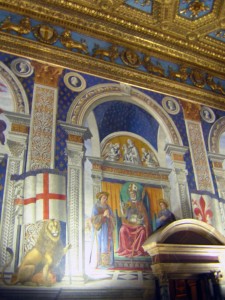
For more than a century the Medici kept being opposed, thrown out, restored, struggling to maintain control of their infamously fractious and rebellious city, until in the early 1500s there was one overthrow too many. The Medici raised a fresh army, marched in, got rid of the Signoria and in 1531 finally had themselves crowned Dukes.
Returning to Vasari…
Architecture remained the physical embodiment of Florence – its government, its church, its people – and the Palazzo Vecchio was by now the solid, permanent embodiment of the authority to rule. The Medici moved in, literally occupying the Signoria’s seat, a permanent end of the Republic. The old palace needed to be redone, and it was Vasari’s job to turn this icon of the long-loved Republic into a symbol of its death and rebirth as a glorious Medici monarchy.
The palace itself he had redecorated with new, more beautiful (and expensive) gilded ceilings, pseudo-Roman frescoes, and a beautiful but unsubtle mural of the Medici besieging Florence, with the simple message: you are here, my troops are here – think about it.
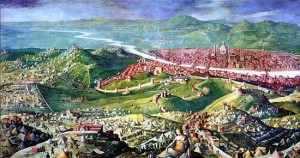
He also tore down the old quarter by the Palazzo Vecchio where the merchant guilds had had their headquarters and created the Uffizi, “offices”, a long, folded neoclassical loggia surrounding a new public square. Inside the guilds were installed into new, nicer, more mathematically harmonious and luxurious lodgings provided by their new ducal master. Below, the new square was comfortable and shaded by the galleries, perfectly situated to be the new center of commerce and civic gossip, again dominated by the elegant silhouette of the duke’s new offices above. Florence’s civic heart was literally transplanted into the duke’s architectural grasp. The offices were then decorated again with Roman-style grotesque frescoes, antiquities, the family’s collection of Renaissance masterpieces, busts of Roman emperors, and portraits of Medici family members and their famous vassals and political allies.
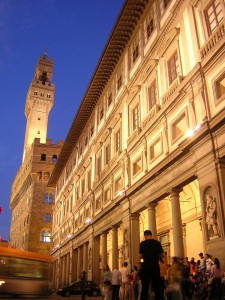
The surface of the Uffizi is all perfect neoclassicism, elegant symmetrical gray window frames and pediments in harmonious mathematical precision, creating a square which feels at the same time new and ancient, and above all planned, intentional, in contrast with the eclectic mix of different eras’ facades which surrounded every other square in Florence and, pretty much, in all of Italy. Even before the installation of the statues of Cosimo Pater Patriae and Lorenzo il Magnifico, the feeling of standing in the square below the Uffizi is the best possible summary of the events: the chaos and liberty of the Republic have been replaced by an educated, organized, neoclassical, irresistible force. Vasari carved that lesson in brick and stone, and made it clear.
He also created the Vasari Corridor, a closed, elevated walkway which starts at the Palazzo Vecchio itself, connects it by a high (dukes only!) bridge to the Uffizi, then on the far side connects the Uffizi to a long hallway which runs well above head height along the river, across the Ponte Vecchio with its tight-crammed sparkling goldsmiths’ shops, through the houses and rooftops of the quarter across the river, and ends at the Palazzo Pitti, a much larger,
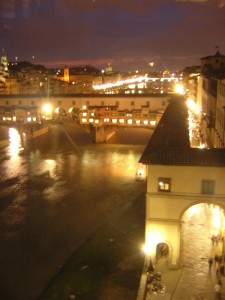
grander second palace which Vasari’s scheme connected with the first. The Palazzo Vecchio was, after all, more than two hundred years old, and a bit cramped and old-fashioned, built for cobblers and dyers, not for dukes. The Pitti Palace had worthier apartments (worthy to house the kings of Italy in the early days of the unification). Now the Duke could walk in assassin-proof safety from palace to palace, even across the river, and more, now the Duke’s movements were a central part of the city’s face. Florentines going about their daily business would (and still) follow along the ducal way, enjoying the shade provided by the walkway above, while all across the city one could see the corridor along the bridge, tying the two halves of the city together like a great artery. Its pulse was the Duke.
Was Vasari a fawning Medici stooge? Essentially. Was anybody NOT at this point? Not who had a job. Artists need patrons, and the Medici were a wealthy, cultured, politically savvy, respectable and above all stabilizing force for a city that had gone through a dozen regime changes in two generations. Vasari was not one of the Renaissance’s greatest painters, nor its greatest architects, nor its greatest authors, but I will nominate him unreservedly for the title of greatest communicator.
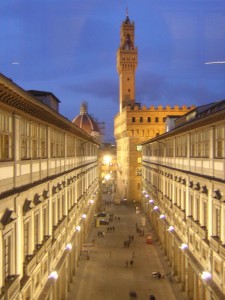
He packed the feeling and intensity of what had happened, two hundred years of chaos and gradual transition, into a series of physical spaces which perfectly teaches the viewer what happened and what this great change meant, even if the viewer doesn’t actually know the specifics of the great events which created these great spaces. Architecture, painting and interior design combine to create a very specific tint of awe, one which really does communicate both what was lost and what was gained.I know no comparable grand architectural scheme—not the Vatican Palace, not St. Peter’s, not the castles of Milan or Naples or even Versailles—which succeeds in channeling history so complicated into a simple view. Florence’s history, as you can tell, needs concise summary or it turns into a saga. Vasari turned it into a vista, and was in that perhaps a better biographer of Florence than he was of his fellow artists.
For that achievement, on his five hundredth birthday, he deserves congratulations.
Jump to an Overview of Florence’s Museums, or Venetian Carnival.
4 Responses to “Vasari, the Palazzo Vecchio and the History of Florence (Begins Introductions to Historic Cities Series)”
-
[…] the connection had to protect the Medici rulers from assassins and observaton. Hence, the Vasari Corridor: an elevated walkway that led from the Palazzo Vecchio, above the merchant shops of the Ponte […]
-
How in the world do you know so much???? Wow! Everything I read on this site is so in-depth. I just found exurb and am so glad to find out stuff about Florence, Rome and history. Thank you
-
[…] If you enjoyed this, see also my historical introduction to Florence. […]
-
[…] If you enjoyed this, see also my historical introduction to Florence. […]


